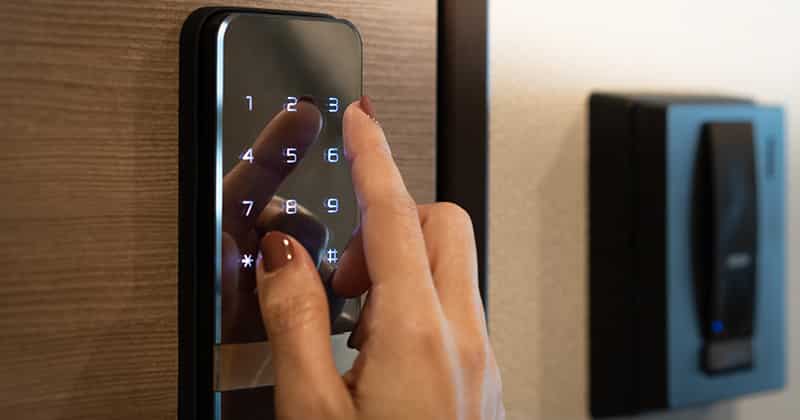
Nowadays, smart technology is just about everywhere you look.
Thanks to easily accessible computing power and limitless connectivity, ordinary home gadgets are getting a digital makeover. We have smart light bulbs, thermostats, speakers, refrigerators, and AC systems—the list is endless. And now we can secure our homes with smart locks.
Smart locks have been raising eyebrows in the locksmith industry for the last couple of years. The technology has now matured enough to hit the mainstream market. Subsequently, the demand for smart locks has skyrocketed.
As a locksmith, general contractor, or home services provider, now is the best time to get into the smart lock business. The opportunity is ripe for the picking.
FROM ONE OF OUR PARTNERS: How to Grow a Service-Based Business
But where would you even start? And is selling smart locks a good business idea in the first place?
First of all, given the prevailing market trends, selling smart locks makes total sense. However, you’ll need a solid sales strategy to get your customers interested in smart locks.
This article has that covered.
We’ll start by looking at the smart lock market size to see if it holds enough potential and opportunities. From there, we’ll discuss essential tips, tricks, and strategies for selling smart locks in your local area. This guide covers everything from identifying potential customers and establishing trust to closing deals.
Let’s dive in.
The Growing Market for Smart Locks

The smart lock industry is booming. According to Mordor Intelligence, the global smart lock market is worth USD 2.43 billion. By 2028, it’s predicted to reach USD 4.98 billion. It’ll register an impressive 15.4% compounded annual growth rate (CAGR) during the forecast period.
North America is the largest smart lock market, while the Asia Pacific region is the fastest-growing.
These figures indicate a thriving, lucrative, and promising industry. And that is also evident in the smart lock adoption rate at the consumer level.
Research by Parks Associates shows that 11% of US internet-connected households (over 12 million homes) owned a smart door lock as of Q4 2021. That’s nearly twice the smart lock adoption rate observed five years prior.
Why are homeowners, tenants, and building managers suddenly so eager to install smart locks?
Here are some of the key factors driving this market growth (according to industry analysts):
Check out this Locksmith Invoice template by Service Fusion
Ever-Growing Security Concerns
There are 2.5 million burglaries in the US every year. Of those, over half (about 1.65 million) are home invasions. Most of these break-ins and burglaries happen during the day when no one is home.
Yet Americans spend more than $20 billion annually on security devices.
On top of that, there’s a growing new breed of daytime burglars known as porch pirates. These are mostly opportunistic, small-time criminals who go around snatching delivery packages from people’s front doors. As of 2022, 14% or about one in seven Americans had fallen victim to package theft, some more than once.
Smart door locks promise to address most homeowners’ security concerns. These locks are designed to deter burglars, including the infamous porch pirates. Some also give users real-time security status updates, alerting them whenever anything stirs near the front door.
Convenience
For some homeowners, the appeal of smart locks is simply the convenience.
Most smart locks are activated using sophisticated technologies such as biometric scanners and proximity sensors. The user doesn’t need to carry around cumbersome keys all day. Besides, keys can easily get lost, stolen, or misplaced. Plus, without carrying a bunch of keys, you save a lot of valuable real estate in your pocket or purse.
Embracing the Digital Ecosystem
The idea of smart homes has really taken off. There are currently over 63 million smart home users in the US alone. And that number is only growing.
Smart door locks are just another addition to the smart home ecosystem.
A densely connected smart home ecosystem simplifies everyday household tasks. And it’s not just a matter of convenience. It turns out that “smart home” is a strong selling point in the real estate industry. As evidence of this, revenue in the smart home market has continuously increased year over year.
Whatever the reasons, full home automation is a priority for many homeowners and homebuyers. Smart security systems, including smart locks, are a big part of home automation.
Speaking of going digital, check out our Locksmith Software.
The Rise of Businesses Offering Home Automation Technologies
Numerous smart lock startups, such as U-tec, Bosma Aegis, and eufy, have cropped up over the last few years. Key market players, including Kwikset, ASSA ABLOY, and August Home, are also keen to dip their toes in the smart lock venture.
Clearly, there’s a strong interest among lock manufacturers to produce smart locks. That says a lot about the validity of the market. More key players joining the scene is good news for the smart lock supply chain and end-consumers.
The ensuing competition pressure inspires innovative thinking. And with innovation comes high-quality smart locks. This competitive landscape is partly why smart locks have become so accessible, practical, and affordable.
Increased Availability of Automation Infrastructures
The infrastructure to support smart locks has matured in tandem with the technology. “Infrastructure” in this context refers to limitless connectivity and automation capabilities.
According to the National Telecommunications and Information Administration, only one in 5 American households is offline. The rest have reliable internet connections.
Another leap forward has been the proliferation of inexpensive computing power. The average modern smartphone is millions of times more powerful than the computer that took Neil Armstrong to the moon. That immense computing power is in the hands of over 90% of the global population.
Not to mention that cloud technologies add a whole new dimension to computing.
Today, smart home devices can seamlessly interconnect over the Internet of Things (IoT). All while being powered by high-speed 5G networks and the unprecedented computing power packed in unassuming gadgets.
The point is that the smart lock has modern connectivity and computing capabilities at its disposal. That’s what makes it work as a mainstream product.
Understanding the Smart Lock Landscape

Before delving into selling smart locks, let’s get the basics out of the way:
- What is a smart lock?
- How are smart locks different from traditional locks?
- What are the various types of smart locks available today?
A smart lock is basically an electronic lock with intelligent features. “Smart” means automation and connectivity capabilities such as remote control, integration with other devices, and active monitoring.
What Can Smart Locks Do?
The best way to understand smart locks is by learning what they can do. In other words, how are smart locks different from other types of locks?
Here’s a list of technologies, capabilities, and features you’ll only find on smart locks:
Keyless entry
With smart locks, carrying keys is a thing of the past. Smart locks use various keyless technologies to lock and unlock. Pin codes, fingerprint scanners, proximity sensors, and voice commands are the most common options. You can also use your smartphone to lock and unlock a smart lock.
Auto-locking
Auto-locking is another excellent feature unique to smart locks. You can set the device to automatically lock your door after a certain period or at a particular time every day. Some will even sense when you leave the house and lock the door behind you.
Integration with other home automation systems
Connectivity is the essence of smart devices. Smart locks can interconnect with other smart devices in your home. They do so via Wi-Fi, Bluetooth, or other IoT-dedicated networks.
For instance, the front door lock can connect with the doorbell, alarm system, and CCTV cameras to create an autonomous home security system. Such a system can automatically lock the door, send an alert, or fire an alarm when it senses a malicious intruder.
Remote access and control
Smart locks are internet-enabled. They can be accessed and controlled remotely using a web or smartphone app. That way, the lock can send security alerts and notifications straight to your phone. You can also lock and unlock the door remotely, for example, to let guests in while you’re away.
Real-time monitoring
Some smart locks are equipped with an array of sensors, such as cameras, microphones, and motion detectors. Others are designed to connect with home monitoring devices to take advantage of their sensors. Either way, these act as your front door’s eyes and ears, continuously monitoring the surroundings.
The high-tech surveillance system can even stream a live feed of your porch right to your phone. More importantly, intelligent monitoring devices can detect suspicious activities and react accordingly.
Customization
Compared to traditional locks, smart locks are highly customizable. You can change just about any parameter on the lock. They have user dashboards where you can reconfigure security, connectivity, and automation settings. Some locks even have updatable/patchable firmware.
Types of Smart Locks
There are many types of smart locks, depending on how you want to categorize them. Smart locks are still so novel that manufacturers haven’t yet standardized them. In fact, any two devices are often so different that each brand can be its own type of smart lock.
That said, we can categorize smart locks broadly into two types: adapted and native smart locks.
An adapted smart lock is a traditional lock retrofitted with smart features. Electronic locks, such as maglocks and even manual deadbolts, can be upgraded to smart locks. A good example of this is eufy’s Retrofit Smart Lock E110, designed to fit over the ordinary deadbolt.
On the other hand, native smart locks are built from the ground up as smart locks. You have to remove the existing lock to install a native smart lock. In most cases, it’s a job that requires a professional locksmith.
Targeting the Right Customers

Before selling new products, ask yourself one crucial question: Who is my ideal customer?
It’s critical that your smart lock venture targets the right customers. Otherwise, you’ll only waste your time and money on futile marketing campaigns. Plus, understanding your target customers should help you identify suitable smart lock devices to sell.
Your primary customers will likely be people looking to install advanced security systems in their homes. Home automation enthusiasts may also buy smart door locks.
Here are five tips for identifying customer segments in your market that might be interested in smart locks:
RELATED ARTICLE: 6 Easy Ways to Get More Locksmith Leads
Conduct Your Own Research.
Find your target smart lock customers by doing a market analysis. Use various tactics to investigate whether your locksmith leads and customers would be interested in smart locks. You can do so in the following ways:
Ask questions in a simple survey.
Design a simple survey asking customers if they’d be interested in smart locks. A short questionnaire with just a few questions will do. Issue the questionnaires via highly interactive means, such as social media and emails, to solicit good responses.
Post smart lock-related content.
Share blog articles, videos, and social media content on smart lock topics. Then, wait to see how the audience engages with or reacts to the content. For instance, examine what type of people like the posts.
Conduct interviews.
Consult local industry experts, realtors, and marketers in your area for insights into the potential of a smart lock venture. You can even interview some of your customers to get their views on smart lock technology.
Do a Trial Run.
Test your market with an actual product. Partner with a smart lock manufacturer or distributor to do a trial run for their device.
The idea is to get a firsthand market reaction without fully committing to the venture. “Testing the waters,” so to speak. Think of it as a soft launch with no inventory or supplier obligations.
All you have to do is advertise that you’re now selling and installing smart locks. Use the usual marketing channels—your locksmith website, social media pages, email, etc. Though, the customer doesn’t have to know it’s a mock launch.
Getting the product out there should give you a good idea of your target customers. Plus, the feedback generated in the test can further inform the venture.
Check Out Your Competitors.
What are your competitors up to when it comes to smart locks?
Find out if any competitors are selling or planning to sell smart locks. And learn how well or poorly they’re selling and who they’re selling to. Also, find out why other locksmiths in your area may be hesitant to jump into smart locks.
The goal here is not to copy the competition. Instead, learn from what they are doing right and their mistakes.
Consider the Popularity of Smart Locks in Your Area

We’ve already seen that smart locks are growing in popularity nationwide. And in both residential and commercial sectors. But that might not necessarily be true in your company’s service area.
Start by checking the local hardware stores to see if lock merchants are stocking up on smart locks.
Next, take the search online. Use Google Trends to analyze the density of smart lock-related keywords in search queries within your region. Facebook and other social media platforms have similar tools that show the search volume or mention of specific keywords.
Smart locks might not be very popular in your region in terms of adoption rate. But if there are signs of interest in the product, that’s a market worth exploring.
Create Buyer Personas
After thoroughly researching the market, create your ideal buyer personas. These are customer profiles of potential smart lock buyers.
List as much information as possible about the customer in each profile, including:
- Spending habits
- Homeownership
- Lifestyle choices
- Home security priorities and pain points
- Income level
- Interest/preferences in home automation
Detailed buyer personas will help you narrow down your ideal smart lock customer.
Sales Tips for Selling Smart Locks

After identifying a viable target market, it’s time to start selling digital locks. Luckily, locksmiths and other home service providers are perfectly positioned to sell smart door locks.
However, introducing a new line of products takes some work and careful maneuvering. You must be fluent in the sales language to convince customers to buy smart locks from your company.
Start by following these six sales tips:
Establish Expertise.
Smart locks, and even the whole idea of home automation, are still new to many people. You must appear knowledgeable in smart lock technology for customers to take you seriously. After all, you’re asking them to trust you in securing their homes.
Kwikset recently conducted a consumer segmentation study for the smart lock market. The study revealed these five types of smart lock customers:
1. Smart home savants
These are people who are very interested in smart home devices. They like to buy high-end gadgets the moment they are released. This customer segment is likely out of your reach.
2. Enthusiastic adopters
These are tech hobbyists and enthusiasts. They are likely to take a DIY approach to installing smart locks. There’s a slim chance they’ll buy from a home services provider.
3. Good life gurus
This group of customers sees value in smart locks but need education to convert.
4. Super moms and dads
These customers are open-minded about home automation. With a bit of nurturing, they can buy your smart locks.
5. Passive purchasers
These are slow adopters who need a lot of educating and persuading to convert.
By these classifications, you should go for the last three segments. And they all need to be educated about smart locks’ benefits, working, and value. You can only do that if you’re well-versed in the home automation industry.
Identify Customer Needs.
A smart lock is an advanced solution to a number of home security problems. An excellent smart lock addresses front door intrusion, surveillance, and automation issues. Do your customers face such problems?
You want to sell smart locks to solve your customers’ security pain points. Use the following strategies to identify those pain points:
- Analyze your customers’ purchase patterns and behavior to understand their preferences.
- Listen to your customers’ complaints and note the most commonly raised issues.
- Ask your customers to share their biggest security challenges.
- Check your local area’s home burglary and break-in statistics.
Build Trust.
In a 2022 survey, 46% of customers said they’d pay more to buy from a trusted brand.
Trust is fundamental in making purchase decisions—even more so when it comes to security devices. Customers who do not trust your locksmith or home services brand certainly won’t buy your smart locks.
Customer trust is not given; it’s earned.
Here are six ways you can build credibility and trust around your brand:
1. Be honest and transparent.
Avoid half-truths and making promises you can’t keep. Also, be clear about touchy issues such as pricing, privacy, and security.
2. Cultivate and protect your company’s reputation.
Provide high-quality home services and products consistently. Excellent customer service also adds valuable points to your company’s reputation.
3. Share positive reviews and testimonials.
Reviews, testimonials, and case studies demonstrate social proof, which helps establish trust.
4. Keep an open line of communication.
Being available for contact is essential in building customer trust. Ensure customers can reach your company anytime and through multiple mediums (phone, live chat, email, social media, etc.).
5. Give service/product guarantees.
Service/product warranties and guarantees show that you’re willing to stand by your word and the quality of your offerings.
6. Build close relationships with customers.
Keep your customers and leads close by continuously engaging them via email, web content, and social media posts. That’s an effective way to nurture customer loyalty and trust.
FROM ONE OF OUR PARTNERS: 5 Quick Tips to Help Home Services Providers Get Repeat Customers
Demonstrate Product Value.
Educate your audience on the value and benefits of smart locks. Remember the good life gurus, super moms and dads, and passive purchasers we discussed earlier? Strategic infomercials could certainly turn them into buying customers.
You’ll need a really good content marketing strategy and a bit of showmanship to pull this off. Try the following tactics to demonstrate smart locks’ value to your audience:
- Hold live demos showcasing smart locks’ amazing capabilities in public venues/events such as trade shows and conferences.
- Populate your website’s blog with detailed product descriptions, comparisons, and buyer’s guides.
- Create convincing online content showing the immense advantages of smart locks over traditional alternatives.
- Post videos on YouTube, social media, and your website showing how smart locks work.
- Publish case studies of previous smart lock installation jobs.
Respectfully Respond to Objections.
When pitching a new product, not every customer will say “yes.” At least not right away. A salesperson must always be prepared for objections. The trick to handling objections is turning them into opportunities for even more personalized pitches.
Let’s go over a few examples of common objections and how you should respond to stay in the game:
“The smart lock is too expensive.”
Make the customer feel comfortable with the price. Explain why the smart lock costs more than ordinary deadbolts and padlocks. Justify the price tag by reiterating the product’s value.
“I don’t need a smart lock.”
Hit them with the classic “it’s better to have it and not need it than to need it and not have it.” But perhaps in a more creative, less cliché phrasing.
“I’ve never heard of your company or this brand of smart locks.”
Prove to the customer that you are indeed a credible company that only sells high-quality services and products. Show them your portfolio of previous work and client testimonials.
Say something like, “Yes, we’re a small company. But that’s a good thing because all our customers get our full attention.”
“It’s too much hassle to install the new lock.”
Reassure the customer that installing a smart lock won’t be bothersome at all. Explain how your team of professional locksmiths will install the lock. Also, talk about offering free installation or an installation discount with the purchase.
“This won’t fit on my door.”
Explain to the customer that they don’t need to worry about compatibility since there are many different types of locks. This might also be a good opportunity to offer a free inspection of the door and the existing locks to assess compatibility. Doing that will bring you a step closer to a sale.
FROM ONE OF OUR PARTNERS: Qualifying Leads: 5 Questions to Ask Every Time
Close the Sale

Once the customer becomes unquestionably interested in the product, it’s time to bring it all in and close the sale.
There are some telltale signs that you have a buyer on the hook. For instance, they’ll ask more specific questions, particularly about the price, installation, product warranties, usage, security configurations, etc.
Be careful not to break the deal after coming so far. Try any of these closing techniques to secure a sale:
Assumptive Close
An assumptive close is thinking wishfully and positively out loud. Talk to the customer as though you’ve already made the sale. Doing so puts the prospect in the buyer’s shoes for a moment.
You can close with a statement like, “Your home is perfect for this smart lock. I can send a locksmith over to install the lock at any time. How does Tuesday sound?”
“Say Yes” Close
Ask a series of questions you know the customer will answer “yes” to. Here are some examples:
- “Does your home have a broadband connection?”
- “Is security a priority in your home?”
- “Do you hate carrying keys around?”
Asking such questions should make the client feel like they’re making the right decision. It also helps suppress objections.
Unique Offer Close
If you’re offering a discount or other perks for first-time smart lock buyers, now is the time to bring it up. That will incentivize the purchase.
For example, you could say, “Did I mention that each smart lock purchase comes with free installation and a lifetime warranty? You can’t say no to that…it’s a steal.”
Now-or-Never Close
Some customers respond better to a bit of pressure. A now-or-never close creates a sense of urgency around the deal.
You could say, “This is the last batch of smart locks for this month.” Or, “If you buy now, I’ll get my team to install it for free.”
Ownership Close
In this technique, you assume the customer has already bought and installed the smart lock. Use optimistic language to show clients how using a smart lock will change their lives.
You could say, “You’re at work. A guest comes over to find a locked house. The system has already alerted you there’s someone at the door. You can even see them on your phone. And with the push of a button, you can let them in.”
Objection Close
This will work on customers interested in the smart lock but hesitant to close the deal. Jump in and ask a direct question, such as:
“I’m sure you’ll agree this lock would be a great addition to your home security system. So, what’s really keeping you from buying today?”
The customer might have an obscure or hidden objection. The idea is to draw it out and address it.
Prior to selling or promoting security solutions, business leaders should always check on regulatory compliance in their state and/or with their attorney.
About the Author
Darrol has worked in the HVAC industry for more than 40 years and has been with Service Fusion for the past 3 years. His areas of expertise include pricing, flat rate strategies, in-the-field HVAC experience, and managing technicians.
Related Posts
Stay Informed
Get the latest news and insights plus, Service Fusion offers and updates.Thank you for your submission.
SHARE